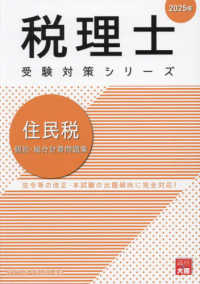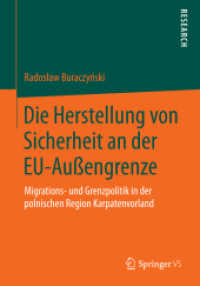Full Description
In 1867 Kusakabe Taro, a young samurai from Fukui, Japan, began studying at Rutgers as its first foreign student. Three years later, in 1870, his former tutor, friend, and Rutgers graduate, William Elliot Griffis, left for Japan to teach English and Science for three and a half years. The year 2020 marked the 150th anniversary of two landmark events in the history of the Rutgers-Japan relationship: the untimely death of Kusakabe only weeks before his graduation, and his friend Griffis' departure to Japan.
Griffis and Kusakabe were only a small piece of a vast transnational network of leading modernizers of Japan in the 1860s and 70s. The Japanese students in New Brunswick were young and innovative men of samurai and aristocratic lineage, who were sent by reform-minded leaders of Japan, which was undergoing a dramatic transformation. They came to New Brunswick seeking Western knowledge that was much needed for the modernization of a newly forming nation. New Brunswick became the hub of a network of Japanese nationals that extended to the major cities of New York, Philadelphia, and Boston, and from there to the smaller towns of New England. Once in New Brunswick, these Japanese students were embraced by Protestant ministers, educators, and missionaries-both men and women-whose network encompassed Rutgers College and the neighboring New Brunswick Theological Seminary, and which stretched to Dutch Reformed parishes throughout the Eastern seaboard, and westward as far as the Dutch enclave of Holland, Michigan. Meanwhile, the American teachers and missionaries who left for Japan became part of a network of reformist leaders and Japanese returnees that extended to schools, colleges, and missions in Japan, and formed the foundations of Japan's modern educational system. Through contributions from scholars and archivists in the U.S., Canada, and Japan, Rutgers Meets Japan aims to reconstruct the early Rutgers-Japan connections and examine the role and impact of this transnational network on Japan and the U.S. in the late nineteenth century.
Contents
Introduction
Part I: The Bakumatsu Network and the First Japanese Students
1 Guido F. Verbeck: Missionary, Teacher and Advisor in Bakumatsu-Meiji Japan
James M. Hommes
2 Envisioning a New Japan: Matsudaira Shungaku, Yokoi Shōnan, and the Bakumatsu Network at the Dawn of the Rutgers-Japan Connection
Haruko Wakabayashi with Fuji Takagi
3 Katsu Kaishū as a Shadow Founder of the Japanese Ryūgakusei Community in New Brunswick: Katsu Koroku, Takagi Saburō, and Tomita Tetsunosuke
Noriko Ochiai and Yukako Otori
Part II: The Japanese Students in New Brunswick and Beyond
4 The Japanese Students in New Brunswick and Beyond: A Comparative Study of New Brunswick and Boston as a Hub for Japanese Ryūgakusei
Satoshi Shiozaki
5 Rutgers in the Nineteenth Century
Fernanda Perrone
6 Reverend Edward T. Corwin and the Japanese Students at the Hillsborough Reformed Church at Millstone
Haruko Wakabayashi
Part III: The American Teachers in Japan: Griffis, Wyckoff, and Clark 7 "Well of Blessing": Griffis in Fukui
Fernanda Perrone
8 Edward Warren Clark in Shizuoka 1871-1873
A. Hamish Ion
9 Fukui's Role in the Career of William Elliot Griffis Joseph M. Henning
Part IV: The Rutgers-Japan Network in Action: The Iwakura Mission and Educational Reform in Japan
10 The Satsuma-Rutgers Connection During the Early Meiji Era
John E. Van Sant
11 The Rutgers Network and the Iwakura Mission: Guido F. Verbeck and Hatakeyama Yoshinari
Haruko Wakabayashi
12 David Murray's Influence on Japanese Education
Benjamin Duke / Edited by Fernanda Perrone
Part V: Reformed Church Missionaries and Early Christian Education
13 James H. Ballagh: The First Rutgers Graduate in Japan
Kōji Nakajima
14 Rutgers Missionaries and Meiji Gakuin
Naoto Tsuji
15 The Contributions of Rutgers and the Reformed Church in America to Women's Education in Modern Japan
Rui Kohiyama
Epilogue-Griffis's Legacies: Rutgers and Fukui
Ryuhei Hosoya







